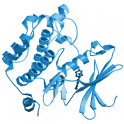
- Remove this product from my favorite's list.
- Add this product to my list of favorites.
Products
Viewed products
Newsletter
 |  |  |  |  |  |

Background: PIM-1 (PIM1) is a serine/ threonine kinase belonging to the group of calcium/calmodulin-regulated kinases (CAMK). The crystal structure of PIM-1 reveals that it is a constitutively active kinase. Phosphorylation is not a prerequisite for its kinase activity, but phosphorylation contributes to kinase stability. The kinase is involved in the regulation of cell cycle progression and apoptosis by phosphorylating e.g. Cdc25A, Cdc25C, C-TAK1, Bad and FOXO3a. Human PIM-1 has multiple roles in tumorigenesis. It promotes early transformation, cell proliferation and cell survival. In addition it may have a role in angiogenesis and vasculogenesis as a downstream effector of the VEGF-A/Flk1 pathway. PIM-1 expression is correlated with tumor aggressiveness and is a marker for poor prognosis. PIM-1 expression can be predictive of tumour outcome following chemotherapy and surgery and has been correlated with the enhanced metastatic potential of the tumor.
Protein concentration: 1.0 mg/ml (Bradford method using BSA as standard protein)
Purification: Expressed in E.coli, one-step affinity purification using Ni-NTA agarose
Purity: > 90% by SDS PAGE
Specific activity : 697,500 U*/mg (1Unit is defined as 1 picomole phosphate transferred to synthetic peptide (KKRNRTLTV) per min at 30 °C)
Theoretical MW (PIM-1): 37.4 kDa (fusion protein)
Entrez Gene ID: 5292
UniProtKB: P11309
Ordering information: shipped on dry ice
Shah N, Pang B, Yeoh KG, Thorn S, Chen CS, Lilly MB, Salto-Tellez M. (2008) "Potential roles for the PIM1 kinase in human cancer ��" A molecular and therapeutic appraisal" Eur J Cancer. 44(15):2144-51.
Bachmann M, Möröy T. (2005) "The serine/threonine kinase Pim-1." Int J Biochem Cell Biol. 37(4):726-30.
Kim J, Roh M, Abdulkadir SA. (2010) "Pim1 promotes human prostate cancer cell tumorigenicity and c-MYC transcriptional activity." BMC Cancer. 1;10:248.
Follow us